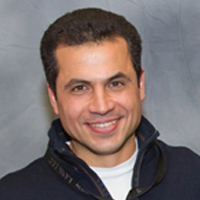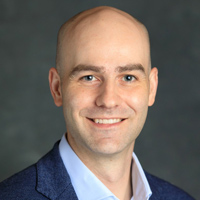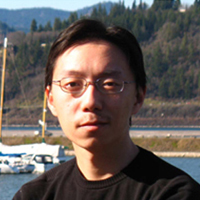Designing Quantum Materials for Transformational Technologies
November 24, 2021
Reading this sentence on a screen may not take very long, but the technology that made it possible took decades of scientific discovery and creative thinking. From the first transistor to supercomputers that can perform 200,000 trillion calculations per second, science and engineering have made giant strides in developing tools that make our lives safer, healthier, and easier. Advances in materials enabled this progress. For example, modern computing would not be possible without semiconductors. Similarly, future revolutions in science, engineering, and technology will be driven by advances in quantum materials. Associate Professor Steve Johnston sees the origins of such enormous gains at the microscopic level. Capitalizing on UT’s multidisciplinary expertise, his plan uses artificial intelligence to predict how quantum materials behave and won $3 million in support from the US Department of Energy Office of Science.

Steve Johnston

Cristian Batista

Adrian Del Maestro

Jian Liu
Classical physics describes our everyday experience. If you drop a baseball from the roof of the Nielsen Physics Building, it’s a sure bet it will fall to the sidewalk below. Predictions like this don’t hold up at the microscopic level, where quantum mechanics are in play. Here, atoms and their smaller constituents can behave in ways that defy classical expectations. Electrons, for example, typically repel one another. Yet in correlated quantum materials they react so strongly with each other that their properties can become strongly coupled and entangled. This leads to phenomena like high-temperature superconductivity, which, as Johnston explained, "emerges from a sea of strongly interacting electrons."
Understanding the behavior of such strongly interacting systems is a grand challenge of modern science. However, quantum materials have potential well beyond scientific curiosity. Consider graphene. While it’s only a single atom thick (and 100 million atoms would fit, side by side, in a centimeter), graphene is 200 times stronger than steel, and electrons move through it 100 times faster than they do through silicon.
The surprising phenomena that emerge in quantum materials have the potential to transform billion-dollar industries ranging from consumer electronics, classical and quantum computing, medicine, and energy production, storage, and transmission. Johnston sees these novel properties as a path to revolutionize technology. Designing those materials, however, requires solving some complex problems.
"If you want to engineer quantum materials for specific purposes then you need to understand the microscopic origin of their behavior," Johnston said. "This is becoming particularly evident when you start coupling different materials together, and new unexpected functionality appears at the interfaces between them. As we develop new quantum materials and incorporate them into novel devices, we need to identify which factors control this functionality."
Central to this is goal—and a key of the DOE-funded research—is demystifying the many-body problem. For physicists trying to sort out how subatomic particles interact when combined in very large numbers, the more particles involved means more possible combinations and hence more complicated calculations. Quantum systems add yet another hurdle.
"The introduction of quantum mechanics adds new layers of complexity," Johnston said. "Many degrees of freedom like the spin and momentum of the electrons can become strongly intertwined. Other degrees of freedom, like the motion of the atoms making up the crystal, can also get mixed in. Modeling all of these interactions at once gets out of control very quickly."
To corral the effort, Johnston and his colleagues will rely on artificial intelligence (AI) and machine learning (ML), which mimic human cognitive processes. Say you have a playlist of your favorite songs. Once you’ve heard it multiple times your brain will recognize the sequence, so when a song ends you automatically know which one will play next. That’s basic pattern recognition. Machines can do this much faster and more efficiently than people.
"AI is incredible at finding patterns in data that humans can overlook," Johnston said. "This is probably going to prove even more so in quantum systems where our intuition and rules of thumb frequently fail."
The DOE grant will give him and fellow researchers an excellent opportunity to put AI tools to work. They intentionally chose quantum systems that have energy-related applications but whose behavior conventional methods can’t adequately describe. When electrons and ions respond collectively, they give rise to properties like superconductivity or quantum magnetism that could provide a starting point for new technologies and devices.
"These classes of models are extremely challenging for modern theoretical approaches, even when armed with leadership class computing facilities like those at Oak Ridge National Laboratory," Johnston said. "We need new computational frameworks to really understand these materials and AI/ML methods can help us create this." This work will also be carried out in close connection to experiments at Oak Ridge and Brookhaven National Laboratories.
UT has a home-field advantage in developing those frameworks.
"Creating these types of methods requires expertise at the interface between physics, electrical and computer engineering, computer science, and materials science," Johnston said. "UT’s ability to lead projects like this is tightly linked to institutional support of interdisciplinary initiatives like the Quantum Materials for Future Technologies cluster."
Along with Johnston, the research team includes UT physicists Cristian Batista (Lincoln Chair Professor), Professor Adrian Del Maestro, and Associate Professor Jian Liu. All are members of the quantum materials cluster, which also includes Assistant Professor Ruixing Zhang and three new assistant professors to be hired this year.
"UT has the critical mass needed to make transformative fundamental and applied advances in quantum materials research," Johnston said.
"UT’s ability to lead projects like this is tightly linked to institutional support of interdisciplinary initiatives like the Quantum Materials for Future Technologies cluster." —Steve Johnston
The university’s team is working with colleagues from Brookhaven National Laboratory, Los Alamos National Laboratory, Oak Ridge National Laboratory, and San Jose State University. The grant also supports multiple graduate students and postdoctoral researchers who’ll have a frontline opportunity to learn cutting edge data science and AI/ML techniques, apply them to quantum materials, and work with a large team including leaders in the field.
The three-year project began September 1 and is one of 10 funded under the DOE opportunity "Data Science to Advance Chemical and Materials Sciences." The awards expressly support multidisciplinary teams, and with a roster of experts working at the boundaries of physics and AI, UT and its partners are well-suited to take on the challenge. Johnston is enthusiastic about their prospects.
"Before going to college and discovering physics, I wanted to be a computer scientist and I have always been interested in the subject," he said. "This is probably why I was drawn towards computational condensed matter. I am very excited to see the true potential of AI and ML in the realm of condensed matter physics and work with these methods. I believe this is going to open up every exciting lines of research that were completely closed to us before."